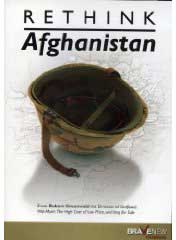 The first thing I noticed about Robert Greenwald’s filmmaking in Rethink Afghanistan is how seriously he cut corners to make the film. For example, seconds into the film, the image quality takes a huge hit as we watch footage he must have pulled off YouTube. Soon after that is an interview that sounds like it was recorded in an echo chamber, the result of inexcusably sloppy audio work. So, is it any surprise that the second thing I thought was: if he cuts corners this seriously in production, with what care does he handle the facts? I’m sympathetic with the primary charge he levels with this film: that this war is having in many cases the opposite effect from the story we tell ourselves. But there’s something off about a filmmaker who’s in such a rush to make a film that he can’t move the microphone a little close to the subject’s mouth to get a clear recording.
The first thing I noticed about Robert Greenwald’s filmmaking in Rethink Afghanistan is how seriously he cut corners to make the film. For example, seconds into the film, the image quality takes a huge hit as we watch footage he must have pulled off YouTube. Soon after that is an interview that sounds like it was recorded in an echo chamber, the result of inexcusably sloppy audio work. So, is it any surprise that the second thing I thought was: if he cuts corners this seriously in production, with what care does he handle the facts? I’m sympathetic with the primary charge he levels with this film: that this war is having in many cases the opposite effect from the story we tell ourselves. But there’s something off about a filmmaker who’s in such a rush to make a film that he can’t move the microphone a little close to the subject’s mouth to get a clear recording.
Synopsis: In a rapid-fire sequence of interviews, news footage, and photos, Greenwald lays out evidence for the case that the United States is making a huge foreign policy mistake by pursuing the war in Afghanistan, and in fact, making the situation there worse.
Story Structure: The film is breathlessly structured around a series of “myths,” which are each quickly brushed aside by a fast-moving parade of interviews and other evidence. For example: “Women are better off in Afghanistan now that the US has removed the Taliban.” Cut to photo of a woman whose face has been eaten away by acid splashed on her by Taliban for showing her face in public. Cut to interview of an Afghan woman saying she fondly remembers the Taliban days, because at least they could stay inside and be safe. Cut to an academic talking about how women are bearing the brunt of violence in the war. The only thing we never cut to is someone acknowledging anything other than horror. Come on, there’s NOTHING good about the Taliban being gone? I’d be more likely to believe his evidence if he at least acknowledged some of the upside. There are so many fast-moving facts, that it seems, there’s no time to even acknowledge other points of view.
Cinematography: Bad. The interviews have no consistency between the way they were shot and lit and many have appalling audio. In fact, it was difficult for me to tell from watching the film whether the filmmaker was actually IN Afghanistan at any point in the filmmaking – it feels like the whole thing is stitched together from news footage and photographs, and interviews that could have been made just about anywhere. Because the quality of the footage varies so greatly, it feels like it was all found somewhere rather than being shot for the film specifically. To give some credit, the b-roll does support the things the interviewee is talking about, often very literally, rather than with much finesse.
Editing: The pacing of this film is way, way too fast. I found myself holding my breath at times, because I thought I was drowning in facts. Facts that I didn’t even have time to question in my own head before new facts were trotted out as further evidence, which are in turn replaced with further, different facts. Makes you crazy after awhile.
Music and Sound: One sound effect I liked is the “swoosh” sound effect that accompanies the flash transition used in the film. The music is in the background adding to the relentless rush of the film.
Bottom line: While I appreciate the filmmaker’s intentions, this film is what low-budget journalism would look like if it didn’t have to drag the burden of fairness around. By slowing down, doing a better job in production, and at least acknowledging the existence of alternative points of view, this could have been a much better film.